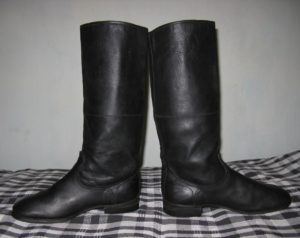 Artificial rubber was invented in the 30s. Until then, states spent huge sums on footwear for soldiers, but they could not fully provide it for their armies. In protracted wars, sometimes it was necessary to fight in only foot wraps. Such a nuisance was less often observed among domestic military personnel who wore so-called eternal boots - cow boots. I wonder what they are made of?
Artificial rubber was invented in the 30s. Until then, states spent huge sums on footwear for soldiers, but they could not fully provide it for their armies. In protracted wars, sometimes it was necessary to fight in only foot wraps. Such a nuisance was less often observed among domestic military personnel who wore so-called eternal boots - cow boots. I wonder what they are made of?
Why are boots called cow boots?
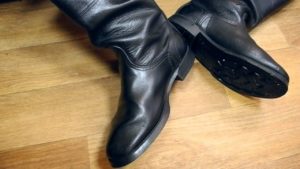 Cowhide or cowhide leather gave this shoe its name. The material is in no way related to tarpaulin, although it is widely believed that tarpaulin and cowhide boots are different names for the same item. In fact the first option - leatherette and products made from it are worn by soldiers, and the second - genuine leather and shoes made from it have been available only to officers since Soviet times.
Cowhide or cowhide leather gave this shoe its name. The material is in no way related to tarpaulin, although it is widely believed that tarpaulin and cowhide boots are different names for the same item. In fact the first option - leatherette and products made from it are worn by soldiers, and the second - genuine leather and shoes made from it have been available only to officers since Soviet times.
Material characteristics
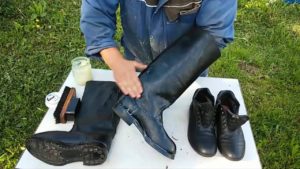 Calfskin. It differs from other cattle skins in its natural thickness.This indicator for the barnacle is approximately 5 times higher than for the slimy and semi-dermal. The difference with opika can reach a 10-fold value, with bull – 2-fold.
Calfskin. It differs from other cattle skins in its natural thickness.This indicator for the barnacle is approximately 5 times higher than for the slimy and semi-dermal. The difference with opika can reach a 10-fold value, with bull – 2-fold.
They take cows from fresh young cows, as well as bulls that are not yet one and a half years old. Place of cut: peritoneum. The location and age of the animal allows us to obtain a large-diameter piece of solid material, undamaged by bites, scars and stretch marks.
After skinning, the hide goes through a lengthy and multi-step tanning process. The technology previously included the following types of processing:
- washing;
- fleshing;
- ash;
- trampling and kneading in drums;
- cutting;
- shavings;
- face push-up;
- heaving;
- pouring in a special tanning solution;
- juice tanning;
- tanning is interspersed.
In modern industry, chrome tanning is used - a chrome tanning method that uses tanning minerals. After such processing, the product becomes, on average, 2 times stronger than hides that have gone through vegetable tanning. The material also begins to have a high welding temperature - its structure does not collapse upon contact with boiling water and resists well the destructive effects of heated chemicals.
Description of the boot design
Features and details of traditional field officer boots:
 leather soles with nails;
leather soles with nails;- each boot has 2 white ears (sewn on the inside);
- the back is reinforced;
- standardized shaft length: 45 cm;
- Guards regiments wore models 4.5 cm longer;
- the boot is sewn at the back, with one long seam;
- standardized weight of insoles: 21.33-46.93 g;
- heel height: exactly 2 cm;
- the heel is secured with iron pins.
What other synonyms for the name exist?
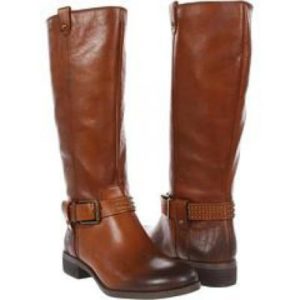 The same material can be called both yalov and yuft. However These words are not complete synonyms, the latter is somewhat broader. It is used to refer to the skin taken from the peritoneum of not only young bulls and cows, but also horses. Sometimes pigs are also used.
The same material can be called both yalov and yuft. However These words are not complete synonyms, the latter is somewhat broader. It is used to refer to the skin taken from the peritoneum of not only young bulls and cows, but also horses. Sometimes pigs are also used.
The third name is chrome. However, it is incorrect. There is a huge difference between real chrome and cowhide boots. The latter provide better ankle support and you can wear them during a fire (or just put out a fire with them). The first ones are considerably lighter, but they have no place near the fire. They tolerate high temperatures much worse.
Important! Popularly, these shoes are also called field and officer shoes.
A little history
Interesting Facts:
 In the world, cowhide and yuft leather are associated with Russia. It is called Russian leather and cuir de Russie.
In the world, cowhide and yuft leather are associated with Russia. It is called Russian leather and cuir de Russie.- The word "yuft" supposedly appeared in the Russian language in the 16th century.
- This differs from the European and American natural materials that became widespread in the 19th century in the way it is processed. Other countries used vegetable tannins, only the Russians impregnated their hides with tar.
- Today, instead of tar, a fat mixture is used, often including seal blubber.
- During the First World War, only Russian soldiers fought in shoes made of genuine leather.
- After World War II, cowhide boots ceased to be the property of servicemen; they began to be worn in civilian life. Everyone sported such shoes, from schoolchildren to bosses. People with modest incomes replaced yuft shoes with kirzachs.
Advantages and disadvantages
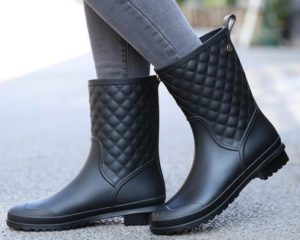 Durability with minimal maintenance – a fundamental feature of traditional cowhide boots. For this quality they were and are valued by military personnel.They do not become moldy without drying in trenches and swampy areas and last even longer than tarpaulin. The latter are inferior in terms of heat resistance.
Durability with minimal maintenance – a fundamental feature of traditional cowhide boots. For this quality they were and are valued by military personnel.They do not become moldy without drying in trenches and swampy areas and last even longer than tarpaulin. The latter are inferior in terms of heat resistance.
Another notable feature is protection of feet from moisture. Excellent hygroscopicity allows you to maintain dryness even after prolonged exposure to water. Hence the demand for this type of footwear among fishermen and tourists.
Important! Yuft or yal traditional boots are difficult to wear in summer. They are hot, but military personnel and conscripts have to put up with this kind of inconvenience.
Advantages go hand in hand with disadvantages. Strength and Durability – with inelasticity, roughness and a long breaking-in process. Hygroscopicity – with problems with sweat removal and oxygen supply to the skin. Natural origin of the material – with high prices for designer women's boots made from it.
The biggest complaint is the kneading (primarily the additionally reinforced rear part). Waiting for natural spread is too long. We have to resort to folk remedies. Mixtures with glycerin, hot towels, and pads are used. Sometimes hard boots are filled with bags of water and sent to the freezer. When water freezes, it expands, creating constant pressure on the walls of the boot.
Modern fashion and cowhide boots
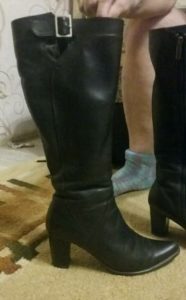 Now among women there is an increase in interest in rough shoes with flat soles or very low heels. Officer's cowhide boots fall under this trend. They are suggested to be worn not only with military-style outfits or skinny jeans, but also with skirts.
Now among women there is an increase in interest in rough shoes with flat soles or very low heels. Officer's cowhide boots fall under this trend. They are suggested to be worn not only with military-style outfits or skinny jeans, but also with skirts.
Changes are also visible in terms of design. The canonical version is complemented by straps, a narrowed silhouette, locks and buckles. There are models with the upper line of the boot, characteristic of cowboy boots.The flat sole is replaced with a hidden slide or even a heel.


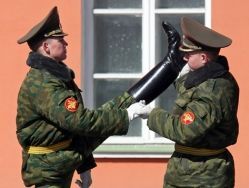 leather soles with nails;
leather soles with nails;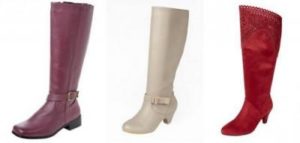 In the world, cowhide and yuft leather are associated with Russia. It is called Russian leather and cuir de Russie.
In the world, cowhide and yuft leather are associated with Russia. It is called Russian leather and cuir de Russie. 0
0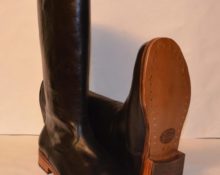
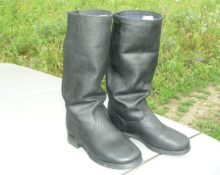

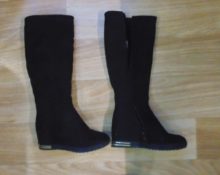
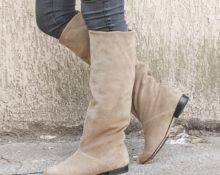


Before asserting anything, you need to be sure of the reliability and truthfulness of this statement, I will reveal to the author one fact about which he does not have the slightest idea.
In Soviet times, cow boots were not only the privilege of some officers, because of the particularly difficult weather conditions, absolutely all privates, sergeants and petty officers of the Red Banner Northern and Red Banner Pacific Fleets wore cow boots, in addition, absolutely all military cadets and cadets wore cow boots. schools, and these are also ordinary personnel, although they are future officers. By the way, absolutely all rank and file personnel who served outside the Soviet Union, such as in Germany, also wore only cow boots.
Very good article, you can find out the height and heel of boots in the Russian army in 1914, cavalry, infantry, artillery.
It should have been written: Low hygroscopicity and not Excellent hygroscopicity.
For two years he wore cowhide boots and a leather belt. (SW Hungary) In the union they wore tarpaulin boots and paper belts.
Cow boots were not only issued to officers.Soldiers also wore them, but not in all troops.
Eternal boots.
Cow boots were also worn by soldiers who served abroad.
The service life of the boots is 1 year. No matter what we smeared on them, they still got wet in winter.
yuft boots were also worn by ordinary sailors in marine units, short
Figurines! They used any means to obtain leather belts! Old man - and in a paper belt this is nonsense))) My face was terribly veteran - shabby to the extreme - special chic! and with autographs of previous generations. After demobilization, I sent the entire uniform by parcel to the unit.
Well, the soldiers in the GSVG wore yuft ones. And the author indicated the difference.
The author either doesn’t know or is lying. At the border the troops in the second year of service were issued cow boots, the leather on the boot was rough and pimpled, so we ironed them with an iron, put on the boot, apply shoe polish and a hot iron, the boot fits the leg, it turns out chic, it was forbidden to do this, but we did it, in our country At the outpost they asked for a tarpaulin (they are lighter), after the service I carried them for another 2 years at work until they finally fell apart.
Absolutely right!
But what about N.S. Khrushchev’s instruction on the mandatory delivery of pig skins after slaughter in a private farmstead, which caused discontent among the population, supposedly for the production of cow boots.
I had cowhide boots, damn it, I dragged them through the forests for two years (but only in spring-summer-autumn), that is, when it’s warm.Yes, they required care. I greased them with pork lard. They didn’t allow water to pass through, but somehow my foot still breathed in them. I only wore foot wraps, no socks.
In the Kantemirovsky division they wore yuft ones (service 1981-1983)
During the Patriotic War, officers serving in the south ordered regimental shoemakers for the summer, for a fee, canvas boots instead of cowhide boots.
Sergey, pride is a terrible sin and your note proves this, because what you wrote, and you wrote the truth, in form seems to correct the careless author, but in fact he also wrote the truth, and you just complemented him, but did It’s not respectful, it’s kind of boorish. Perhaps this is how you assert yourself?
Taman division only yuft, tarpaulin was banned, but they wore it on the sly, usually in the summer, in addition to the P/Sh uniform in winter, years of service 1983-85
At military school and then as an officer, I had to wear cowhide boots. True, the officer tried not to wear them unnecessarily. At the school they envied the soldiers who wore tarpaulin boots, since cowhide boots were heavy and it was difficult to do cross-country runs, exercises on the horizontal bar, etc. with them. In addition, in the summer my feet sweated a lot in them, and in combination with widespread diseases of foot fungi, this caused even more displeasure from wearing them.
Yalovaya (yalovy), resting, unwalked cow (bull).
and all groups of troops outside the USSR wore them. But not 3 pairs for 2 years like a tarpaulin, but 2 pairs for two years.
What's so good about the army now - ankle boots. I fell into a puddle and that’s it, my feet were wet. Which kind of warrior are you in the late autumn, in the trench? By morning you will be left without legs. I changed the footcloths in my boots and my feet were dry and warm again.
Finally. Clear and to the point.
Great boots. At 6-7 months of service, the first boots began to be covered. For 3 “vessels with elixir” I exchanged officer’s ones from the privateer’s warehouse, went for the remaining 1.5 years and no problems at all.
1981-1983 Mongolia, they wore exclusively yuft boots (kirzachi were banned), the term “yalovye” was not used.
1978-1980 Mongolia, yuft and leather belts
I served in the border troops from 1969 to 1972. We were all given cow boots, not the officers. During my service I received tarpaulin, cowhide and yuft boots. I went home in chrome clothes - a gift from the outpost commander.
In the Soviet army, they issued tarpaulin boots, but they gave yuft ones for ceremonial ones, tarpaulin boots for six months and yuft boots for the entire period of service; Severe infection. But they are strong, I wore them in cold weather below -30, they weren’t dull
That’s right. I wore a tarpaulin for service, and yalkova and yuft ones for the weekend. You can’t run 25 km in the mountains in them. Even craftsmen used an iron and water to break an accordion on them. I didn’t like it, bottles are more beautiful.
2 years in the GSVG only yuft, don’t try to talk, these are officers’ yavlovye, in civilian life I bought yaft from a friend of the fire chief!
Is he not an officer?
The first comment is the most correct, and the author has ever held it in his hands (we are not talking about using these things for their intended purpose). Of course not, advertising, money, LIKES - this is the purpose of knowledge and articles. All knowledge is from the Internet, but there is no knowledge there and cannot be by definition, and this is unfortunately an axiom.
And, as for the question about the site, the browser is the MOST important, and I have 4 of them on my computer,
so what? Shall we ban?
I brought it from the service, exchanged it with one ensign for stew, I can’t say anything good about these boots, the fact that the leather is natural is a plus, and the rest is a minus. They are terribly heavy and require constant care; they have dried out a little and turned into stocks. They lay in the basement for a year, it seemed as if they had turned into plywood, and they rattled just the same. I tried everything to revive them, they softened a little and that was all. So I left it in the basement when I moved.
Damn, I’m surprised how we “hoofed” up the hills in the Yuftevs!!!! …. yes, heavy but strong... two pairs were enough for me to travel all over Mongolia for 2 years, and I exchanged some in warehouses and ironed them into a bottle and went to demobilization in them, plus they were finished in psh....
He also took the PSh from the ensign, both the officers’ boots and the PSh. I can’t say anything about the boots, maybe the soldiers’ yufta boots are better, I don’t know, I spent two years in tarpaulin boots, I went for demobilization in the Yalovye and PSh, naturally I tamped and sharpened the heels a little, and the rest was according to the regulations.
Yes, but the inside of the boots were trimmed with thin yellow leather, and in the picture they weren’t the same, the officer’s boots were like boots, the back had a larger cutout than these.
First, second, first, second, but it’s not clear which is the first and which the second. The author has no idea how to write.
those who served abroad wore Yuftev, Yalovye – field officer’s boots,…. And what kind of female bastards are these, standing with their toes turned up? What is it ?)
Anna, of course I understand that it’s holidays, but not to the same extent........ Did you want to say something?
The author has NO idea about boots!!!!
She simply confuses yuft boots and lame boots!
Yuft boots were worn by soldiers and cadets/officers. Their methods of attaching the outsole were radically different: the soldiers' soles were on nails, and the officers' soles were glued. And the dressing of the leather was different, well, just radically! The soldiers' ones, moreover, stank monstrously!!!!
And there were also yuft boots with thick micro-pork! And in price in Soviet times they differed little: 21-50 and 22-50 (on a micro-pork). I haven’t met any officers yet.
The person doesn’t know how to read, but complains that others don’t know how to write))). Typical for our time))).
In general, it is strange that the author herself did not wear cowhide boots, did not conduct research on how and where and with what to wear them, did not send them to different troops, and did not learn in detail from a couple of million people their varied experiences with cowhide boots. So many experts, so many unrecognized experts))
The Marines wore cowhide boots. Officers are fastest in chrome, but not sure. Visually they looked much better than for ordinary personnel.
They were a bit heavy, but for some reason it was easier (probably drier) with the replacement, so they took Fizo. But there were no mass fungal diseases, as they write here.
The officers wore, as far as I know, chrome, not yuft boots. The author lumped chrome, yuft and cowhide boots into one pile.